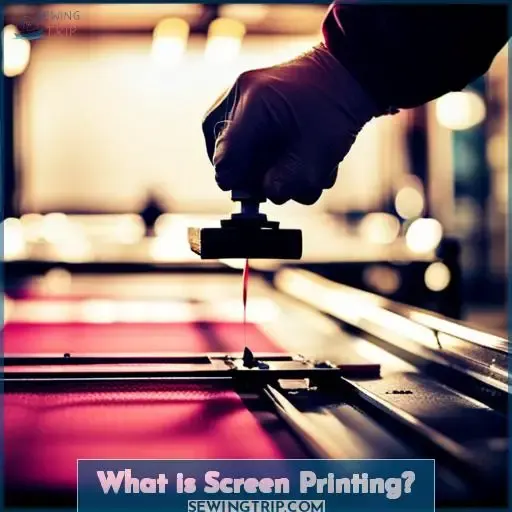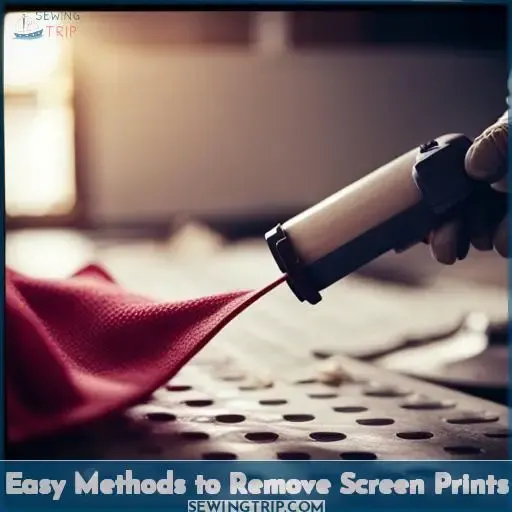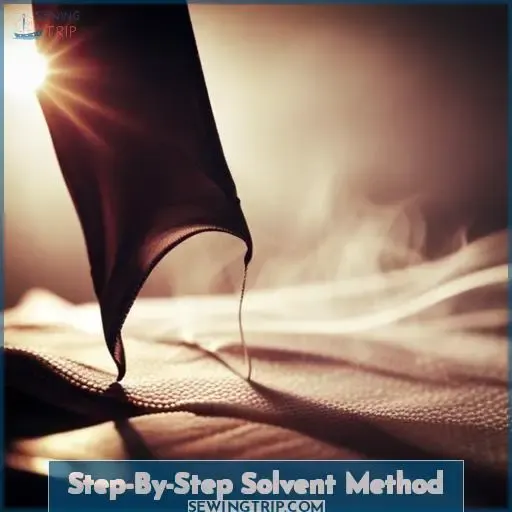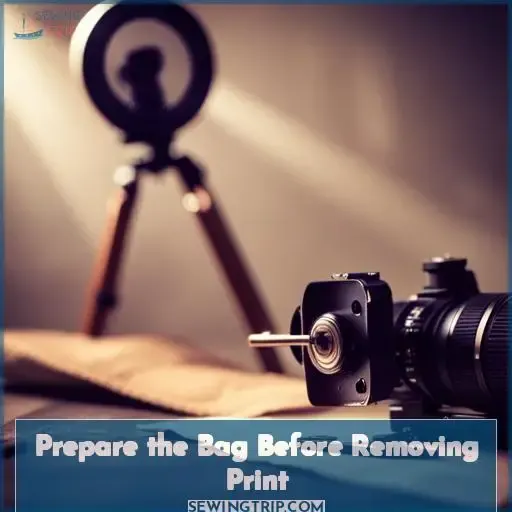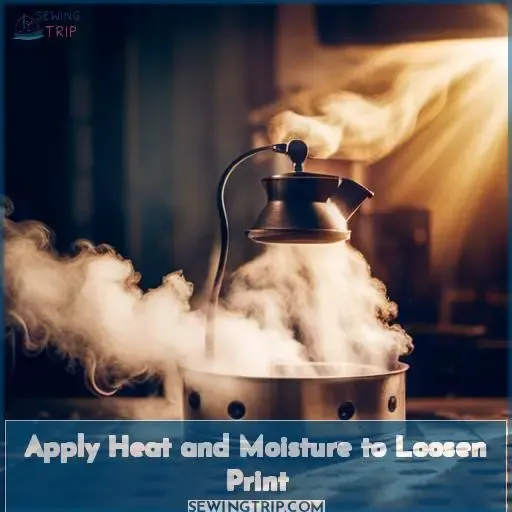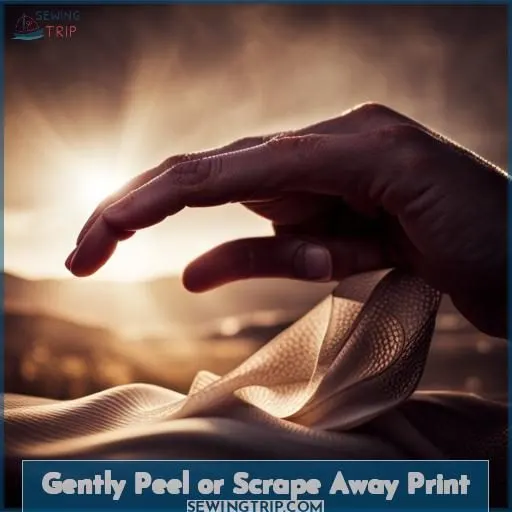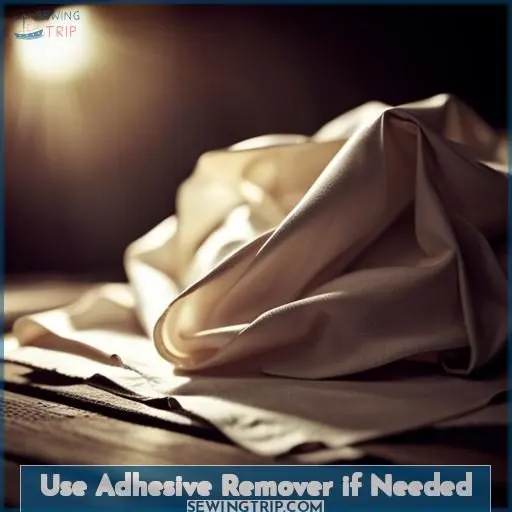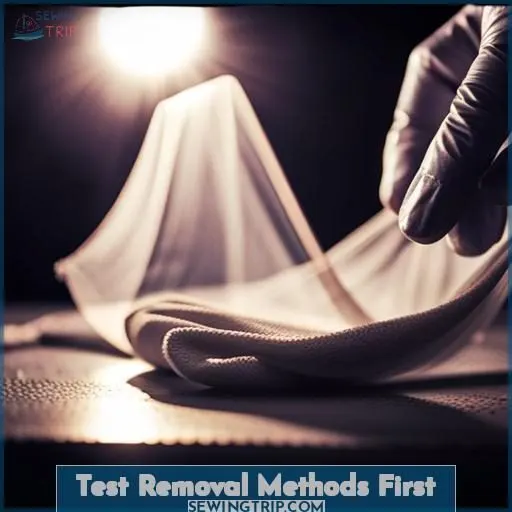This site is supported by our readers. We may earn a commission, at no cost to you, if you purchase through links.
 While screen-printed cloth bags are cool, the prints might not always appeal to you.
While screen-printed cloth bags are cool, the prints might not always appeal to you.
This is especially true with bags displaying wild, non-complementary colors.
If you’re looking for an easy and effective way to remove prints from your favorite cloth bag without damaging it, this article will guide you through four simple methods that can help you reclaim your bag’s original look.
Table Of Contents
- Key Takeaways
- What is Screen Printing?
- Easy Methods to Remove Screen Prints
- Step-By-Step Iron Method
- Step-By-Step Solvent Method
- Prepare the Bag Before Removing Print
- Apply Heat and Moisture to Loosen Print
- Gently Peel or Scrape Away Print
- Use Adhesive Remover if Needed
- Test Removal Methods First
- Get Reliable Screen Printing Services
- Frequently Asked Questions (FAQs)
- Conclusion
Key Takeaways
- Test removal method on inconspicuous area of bag first.
- Apply solvent generously behind print; let soak in before scraping.
- Work slowly and patiently; removing prints takes time and effort.
- Handle solvents carefully; use in a well-ventilated area.
What is Screen Printing?
When you’re screen printing, a stencil transfers ink onto a surface to create a design.
Screen printing, also known as silkscreening or serigraphy, is a printing technique that uses a mesh screen to transfer ink onto a surface, forming a print.
The artform originated in China over 2000 years ago and was later adopted in Japan.
Today, it’s used to print designs on fabrics, posters, circuit boards, and more.
Artists utilize screen printing for its bold, graphic styles.
It allows them to layer colors and textures.
The industry relies on screen printing for mass production of t-shirts, labels, decals, and promotional items.
You can even try screen printing at home with DIY kits.
There are ways to remove screen prints from fabrics like acetone, but take care when handling chemicals.
Understanding the history and modern uses of screen printing provides context when removing prints from cotton and other textiles.
Easy Methods to Remove Screen Prints
You can remove screen prints from cloth bags using common household products.
Try using acetone, sugar scrub, plastisol remover, or the iron and paper bag technique for best results.
Each method has its own advantages, so review them to determine which is right for your fabric.
Acetone/Nail Polish Remover
To remove screen prints from cloth bags:
- Use acetone or nail polish remover.
- Pour the remover onto a pad or cotton ball.
- Gently rub it against the print in circular motions until the design fades away.
- This works quickly for most fabrics except polyester.
Take precautions since it’s a strong solvent.
Consider spot removal fluids as a safer alternative that targets stains precisely.
Sugar Scrub
You can use a sugar scrub to gently remove the print from delicate fabrics or older prints.
Create a paste by mixing table sugar with warm water.
Gently rub the sugar scrub into the screen print using circular motions to exfoliate the ink.
Take care not to abrasively scrub delicate fabrics.
Rinse with cool water when finished.
The natural sugar crystals will lift away the ink without damaging the underlying cloth bag material.
Plastisol Remover
Soak a cloth in plastisol remover and place it over the print design for 20-30 minutes to loosen the ink.
Apply a generous amount to fully saturate the design.
Leave on for at least 20 minutes for the chemicals to work.
Use a scrub brush to gently remove any flaking ink bits.
Wash thoroughly afterward to remove all chemicals.
Iron & Paper Bag
You’re in luck because an iron and paper bag can also help remove screen printing from cloth bags.
This method is safe for fabric sensitivity and offers multiple applications.
The heat tolerance of the fabric should be considered before proceeding with this technique.
By using an iron on a low setting, you can melt the printed design onto the bag, allowing you to easily peel away any leftover ink residue.
Remember to exercise caution when handling chemicals and follow proper safety protocols throughout the process for optimal results.
Step-By-Step Iron Method
By folding a towel inside the clothing underneath the print, you’re preparing the surface for ironing.
Gently apply a hot iron against a damp cloth over the print, listening closely for the water fizzing and evaporating.
With your hand flat across the iron, apply light pressure to loosen the stubborn print.
Lift and reposition the iron as the cloth dries to evenly distribute the heat.
Once fully dry, the fabric’s weave should be preserved, with the print ready to scrape off with a knife or peel with your fingers.
For alternative techniques, a chemical solvent poured behind the print can dissolve inks without heat, but test first in an inconspicuous area.
With patience and care, you can remove prints from cloth bags while preserving the integrity of the fabric.
Step-By-Step Solvent Method
Application of common household solvents presents another effective technique for removing screen-printed designs.
Utilize solvents like isopropyl alcohol, Goo Gone, or a heat transfer vinyl remover.
- First, test the solvent on an inconspicuous part of the fabric to check for discoloration or damage.
- Next, with gloved hands, turn the bag inside out and place it flat on a clean surface.
- Then, gently pour a small amount of solvent onto the backside directly behind the printed area. Let it soak in briefly. Flip the bag over and peel or scrape away the print slowly.
The solvent dissolves the ink, allowing it to transfer to the glove or scraper. With patience, solvents can lift even dark, polymer-based prints on natural and synthetic fabrics.
Yet steer clear of excessive use, as these chemicals burden waterways and soil. A dab will do the trick, then wash as usual.
DIY greenly and safely.
Prepare the Bag Before Removing Print
Before removing the screen print, fold a towel to fit inside the bag below the print area.
Examine the bag’s fabric and construction before attempting print removal.
Natural fibers like cotton and linen are more resilient, while synthetic blends may be prone to damage.
Inspect the ink for vibrant, multi-layer prints that penetrate deeper versus single pigment block prints.
Test a hidden spot to check heat and chemical sensitivity.
Ensure adequate ventilation when using solvents.
Always keep the bag’s integrity in mind throughout the removal process.
Certain preparation steps allow safer, more effective elimination of the print from your treasured cloth bag.
Apply Heat and Moisture to Loosen Print
Having prepared the bag, apply a hot iron against a wet cloth over the print to loosen it.
-
Press a hot iron against the wet cloth over the print.
Apply gentle pressure with your hand.
-
Listen for the water fizzing and evaporating.
This indicates the heat and moisture are penetrating the fibers.
-
Lift the iron when the cloth is completely dry.
The combination of heat and moisture helps break down the inks for easier removal.
Now you can gently scrape off the print with a dull knife or peel it off carefully with your fingers.
The heat and moisture loosen the print to simplify removal.
With care, you can lift most screen prints off the fabric.
Gently Peel or Scrape Away Print
After heating and moistening the fabric, it’s time to gently peel or scrape away the loosened screen print.
Using your fingers, slowly lift a corner of the print and pull it away from the fabric.
For more stubborn prints, use a dull knife or spoon to gently scrape the design off the surface. Scrape in the direction of the threads rather than against them to protect the weave.
Take care not to press too hard or drag the knife sideways, which can snag or cut the fibers.
Work carefully and patiently until all traces of the print are gone.
With the right technique, you can remove screen prints from cloth bags while preserving the integrity of the underlying fabric.
Proper removal opens up creative possibilities for giving used bags new life.
Use Adhesive Remover if Needed
After removing the screen print, use an adhesive remover if any sticky residue remains on the bag.
Select a chemical-based adhesive remover formulated to dissolve the sticky glue without damaging the fabric.
Before applying, always test the product on a hidden area of the bag to check for discoloration or damage.
Use gloves and work in a well-ventilated area.
Apply a small amount directly onto the adhesive residue and let it soak in for a few minutes.
Gently rub with a soft cloth or brush in circular motions until the residue dissolves.
Rinse thoroughly with water to remove any chemical residue.
For a non-toxic option, try soaking in a solution of warm water and baking soda to loosen the adhesive.
With patience, you can remove screen printing completely without harming the cloth bag.
Test Removal Methods First
Before fully removing screen printing from your cloth bags, it’s wise to test out the method first.
Choose a small, hidden area of the bag away from the main design.
Test for fabric compatibility, chemical sensitivity, heat resistance, and ink composition.
Cloth bags may be cotton, polyester, nylon, or blends.
Acetone works on cotton but not polyester.
Sugar scrub is gentle for all fabrics.
Polyvinyl chloride (PVC) coated bags resist heat.
Air compressors push ink deeper into fabric pores.
If the sugar scrub test removes a fresh ink print, use it on the entire design.
For older prints baked into the fibers, try a chemical solvent.
Take precautions and check for material sensitivities to avoid damage.
Start small, then confidently remove the whole print.
Get Reliable Screen Printing Services
Removing screen-printed designs from cloth bags can take some work, so get reliable custom screen printing from professionals like PGI Services the first time around.
As a textile engineer, I recommend partnering with printers like PGI that stay ahead of printing trends with sustainable inks and artistic collaborations.
By upholding industry standards and embracing digital innovation, PGI delivers quality prints you can feel good about.
Whether producing short runs or high volumes, their expertise ensures your designs last on cloth bags and apparel without needing removal down the road.
Ultimately, preventing print removal hassles starts with the right commercial screen printing partner committed to your brand and vision.
Frequently Asked Questions (FAQs)
How do I remove screen printing from spandex or stretchy material?
Use a solvent like acetone or nail polish remover.
Test on a hidden area first.
Apply it to the back of the fabric, let it soak through, then gently peel off the print from the front.
Wash afterward.
Avoid high heat when removing prints from spandex or stretchy fabrics.
Is there a way to salvage the original color of the fabric after removing the screen print?
To salvage the original color, be patient and persistent.
Repeated cleanings with a color-safe detergent may lift the print dye from the fibers.
Consider spot-treating or gentle bleaching if needed, testing first for colorfastness.
With care, the underlying shade can reemerge in time.
Can I use bleach or other household cleaners to remove screen printing?
Don’t use bleach or other household cleaners.
They can damage the fabric and set the ink, making removal harder.
Stick to gentler methods:
- Rinsing with cold water
- Using a solvent specifically made for removing screen printing ink
How can I avoid damage to the fabric when attempting to remove screen printing?
Use the mildest removal method for your fabric.
Test solvents in an inconspicuous spot first.
Avoid abrasives that could damage fibers.
Handle delicately and stop if damage occurs.
Let products fully dry between applications.
Is it possible to remove thick, plastisol-based screen printing ink without chemicals?
Unfortunately, no.
Thick plastisol ink requires chemical removers to fully lift from fabric.
Some hand removal is possible with repeated scrubbing, but chemicals are necessary for complete removal without damaging the fabric.
Consider eco-friendly options like plastisol remover spray.
Conclusion
Like a moth shedding its cocoon, with a few simple methods, you can gently peel away the screen-printed layer to reveal your bag’s original brilliance underneath.
By preparing the bag, applying heat, and using solvents or abrasives, the prints can be safely removed without damage.
With your refreshed cloth bag in hand, you’ll look forward to filling it with new memories, confident that future prints can be removed when the time is right.
Even the most vibrant screen printing is no match for your ability to give your favorite cloth bag new life.

